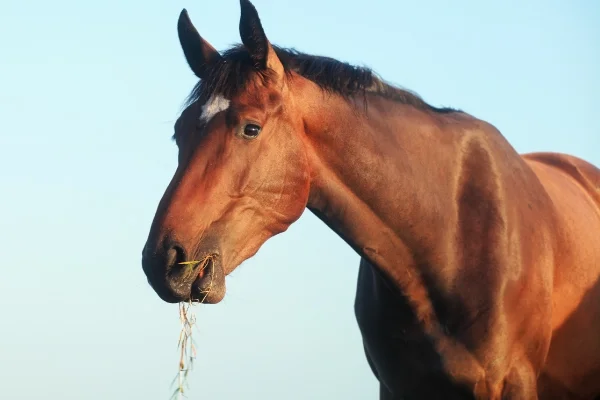A shoulder injury in horses is a fairly common occurrence. It can result from many things, such as a fall or getting hit by another horse.
While some horse shoulder injuries are minor and can be treated with basic care, others can be more serious and may require surgery.
In this blog post, we’ll discuss the different types of shoulder injuries that horses can suffer from and how they are treated. We’ll also cover some prevention tips to help keep your horse safe.
Shoulder injury in horses symptoms

A shoulder injury in horses can be a debilitating condition, and it’s important to know the symptoms so that you can get your horse the help he needs.
Some of the most common symptoms of a shoulder injury in horses include general lameness, reluctance to move the affected limb, and abnormal positioning of the limb.
If you notice any of these signs in your horse, it’s essential to get him seen by a veterinarian as soon as possible to determine the best course of treatment.
Causes of a Horse Shoulder Injury
If you’re a horse owner, it’s essential to be aware of the causes of shoulder injuries in horses. Here are five of the most common reasons:
- Landing after a jump. When a horse takes off into the air, it can land with all their weight on their front legs, which can cause a shoulder injury.
- Carrying excessive weight. If a horse carries too much weight, it can put unnecessary strain on their shoulders.
- Poor saddle fit. A saddle that doesn’t fit well can cause pressure points on the horse’s back and shoulders, leading to pain and inflammation.
- Overuse. Horses who are used for strenuous activities such as racing or show jumping
How to treat a horse with a shoulder injury?
Treating an injury can be physically exhausting for both you and your horse, but the process will be less stressful on your horse if they are kept calm and monitored closely.
A horse with a shoulder injury can be treated by first identifying the cause of the injury. The injury may result from either an impact injury, such as being kicked by another horse or falling or more of a chronic issue involving repetitive friction on the joint due to faulty gaits.
For injuries related to impact, veterinarians have found that cold hosing of the injured area with cold water for 15 minutes every hour reduces inflammation and relieves some pain.
Prevention of Horse Shoulder Injuries
A horse shoulder injury is a severe condition that can lead to a permanent disability or death. To prevent the damage from occurring, stable managers should take steps to ensure the safety of their horses.
These steps can include providing adequate bedding, ensuring both pasture and stall surfaces are soft and free from stones, removing sharp objects near the horse’s feed or water, and ensuring enough space within stalls for movement.
Exercise is also necessary for healthy horses who will not injure themselves while running around.
Horse shoulder injury recovery
If your horse suffers a shoulder injury, it is essential to understand the proper rehabilitating and recovering injury.
- Get a physical therapist to work on your horse’s shoulder.
- Keep the horse in an exercise pen and walk him around for about 10 minutes per day.
- Put a sling on the horse to keep his weight off of his injured limb.
- Give your horse some time off from strenuous activities like jumping or cantering.
- You can help reduce pain and inflammation by applying cold packs to the affected area.
- To help with mobility, try using anti-inflammatory medications with heat therapy.
Horse shoulder lameness treatment
One of the most common injuries horses experience is lameness in the shoulder. There are many potential causes of a horse shoulder lameness, but fortunately, many treatment options are available.
- The first step in treating horse shoulder lameness is to take a complete history of the animal’s symptoms.
- Next, perform a thorough physical exam to determine any abnormalities.
- Treatment for horse shoulder lameness should include rest, anti-inflammatory medications, and possibly surgery.
- When dealing with an injured horse, it is important to consult with your veterinarian before doing anything else.
Horse tight in shoulders
After riding for hours, most horses will experience tight muscles in their shoulders.
This is because the horse has been bearing its weight on this one muscle. You can help the horse’s soreness by loosening the rider’s cinch and giving it a break. You can use a shoulder relief cinch for horses.
A horse with tight shoulders is often ridden for hours before becoming sore due to carrying on that one muscle group.
Soft tissue injury in horses shoulder
A horse’s shoulder is the area near the top of their front leg, often referred to as the “point of elbow.” This area is composed of cartilage and other soft tissue vulnerable to injury.
The cartilage in this area does not have a lot of blood flow, making it difficult for any minor injuries to heal.
Horse owners should be careful when handling their horses in this area to avoid causing any further damage.
Nerve damage in horses shoulder
Nerve damage in horses, also called equine protopathic neuropathy, is a condition that causes loss of sensation in the limbs, which causes difficulty in knowing where the leg is and where it should go.
The nerves typically send information to the brain to know what is happening, including sensing touch and pain.
When the nerve cells are damaged, they cannot communicate with the brain, so we feel everything less acutely.
Cinch for shoulder injured horse
A horse can suffer from a severe injury to its shoulder and still walk but needs to be cinched for the safety of the horse and rider.
The saddle will help balance the horse’s weight to work through pain while still providing support.
Horse shoulder anatomy
The horse shoulder has an anatomy that is very different from human anatomy.
The most visible difference is the external skeletal muscles, which are heavily developed in horses to stabilize their large, heavy bodies.
Horses have larger muscles in their front legs than they do in their back legs, which work together to give the animal a powerful kick.
How do you tell if your horse has a shoulder injury?
A shoulder injury is a broad term that includes any damage to the upper limb due to various causes. Shoulder injuries can be challenging to diagnose because they can result from multiple causes, and there are many ways that the injury could manifest in terms of pain for the horse.
Before treating your horse, it’s important first to evaluate his condition. Look for swelling, heat, bruising, or discharge from wounds on or near the joint.
Can a horse recover from a shoulder injury?
A horse can recover from a shoulder injury, but vets often need to perform surgery on the area.
A horse may recover without surgery if they do not show any initial signs of pain or lameness when the injury occurs.
Horses that are older or less fit will also have more recovery time when dealing with an injury in this area.
If the veterinarian recommends surgery, recovery time can take anywhere from 4-6 months before the horse is fully healed.
What are 3 common horse shoulder injuries?
Horses are susceptible to several injuries, but one of the most common is the injury to the horse shoulder. Some of the most common injuries associated with a horse shoulder are:
- Traumatic shoulder luxation
- Clavicular fracture
- Elbow Injury
Traumatic shoulder luxations account for about 9% of all equine fractures every year.
Final Word:
A horse shoulder injury is a severe condition that must be treated immediately. The veterinarian will decide on a treatment plan after assessing the severity of the injury.
To prevent a horse shoulder injury, people need to take the time to assess the terrain before engaging in horseback riding.

My name is Kenneth E. Johnson and I am an equestrian enthusiast. I have a passion for helping others learn more about horses and their care, and I have written extensively on topics such as nutrition, behavior, health, riding, care, etc.
